A new hybrid fuzzy time series forecasting model based on combing fuzzy C-Means clustering and particle swam optimization
Fuzzy time series (FTS) model is one of the effective tools that can be used to identify
factors in order to solve the complex process and uncertainty. Nowadays, it has been widely used in
many forecasting problems. However, establishing effective fuzzy relationships groups, finding proper
length of each interval, and building defuzzification rule are three issues that exist in FTS model.
Therefore, in this paper, a novel FTS forecasting model based on fuzzy C-means (FCM) clustering
and particle swarm optimization (PSO) was developed to enhance the forecasting accuracy. Firstly,
the FCM clustering is used to divide the historical data into intervals with different lengths. After
generating interval, the historical data is fuzzified into fuzzy sets. Then, fuzzy relationship groups
were established according to chronological order of the fuzzy sets on the right-hand side of the
fuzzy logical relationships with the aim to serve for calculating the forecasting output. Finally, the
proposed model combined with PSO algorithm has been applied to optimize interval lengths in the
universe of discourse for achieving the best predictive accuracy. The proposed model is applied to
forecast three numerical datasets (enrollments data of the University of Alabama, the Taiwan futures
exchange(TAIFEX) data and yearly deaths in car road accidents in Belgium). Computational results
indicate that the forecasting accuracy of proposed model is better than that of other existing models
for both first - order and high - order fuzzy logical relationship.

Trang 1
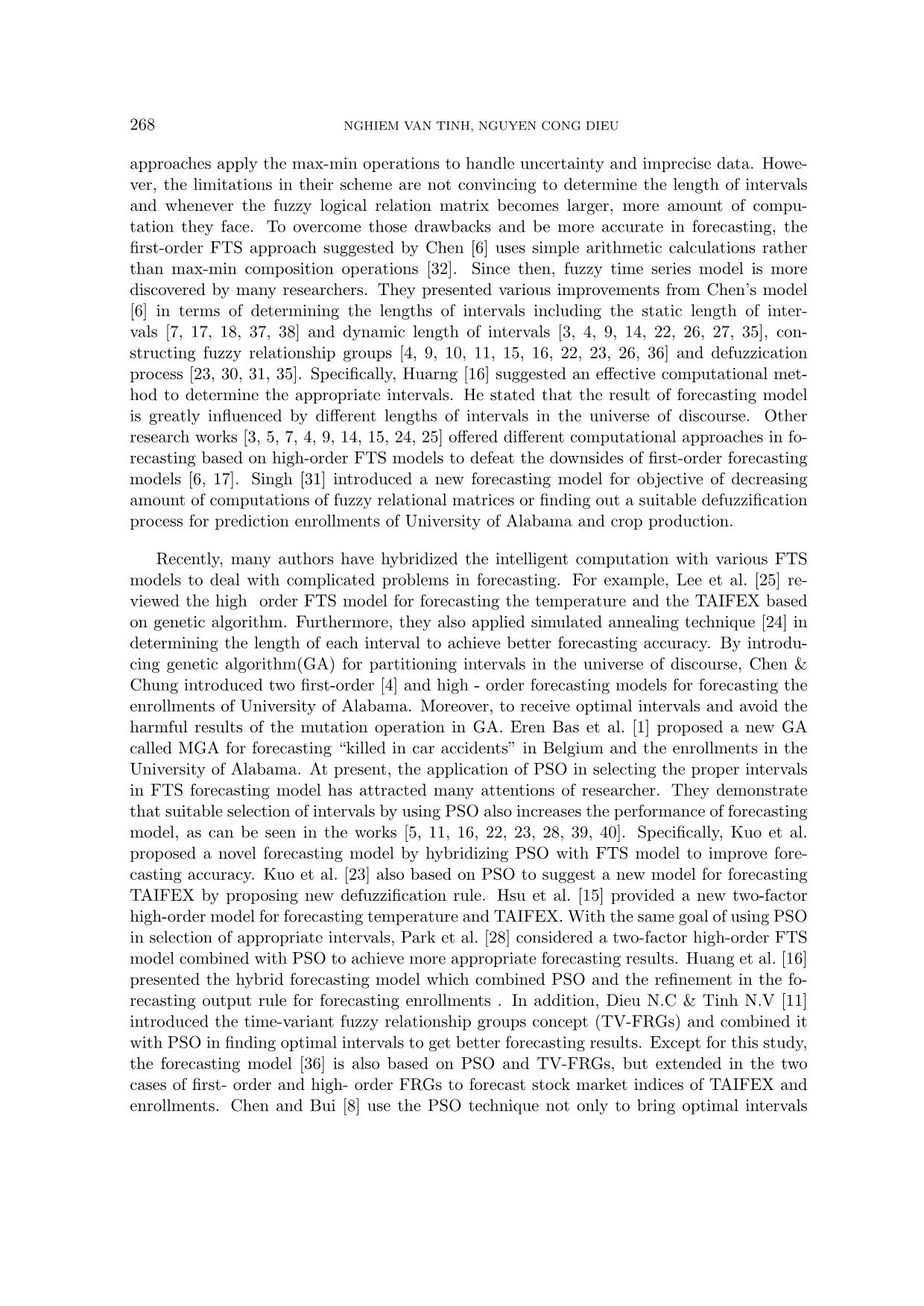
Trang 2
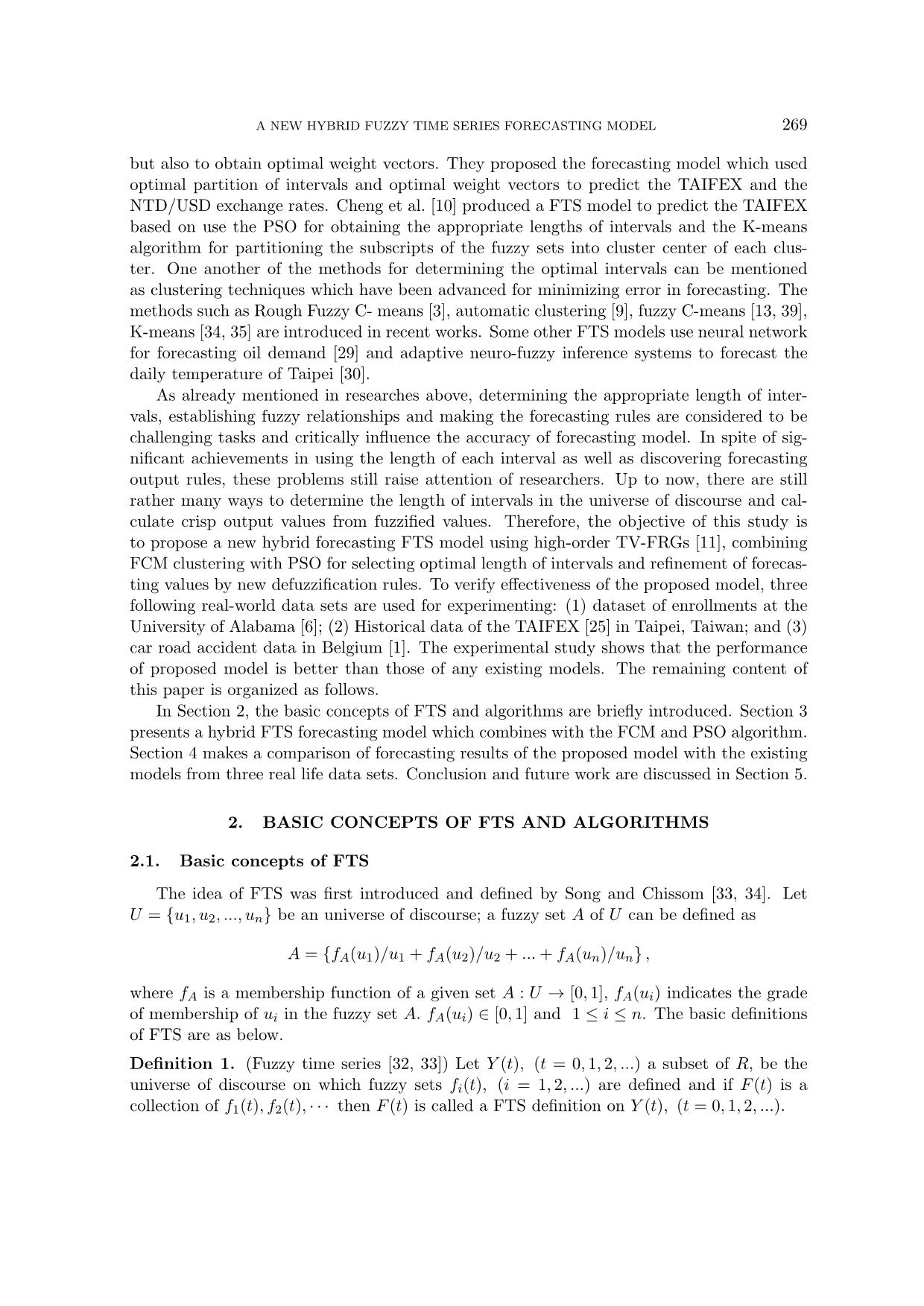
Trang 3
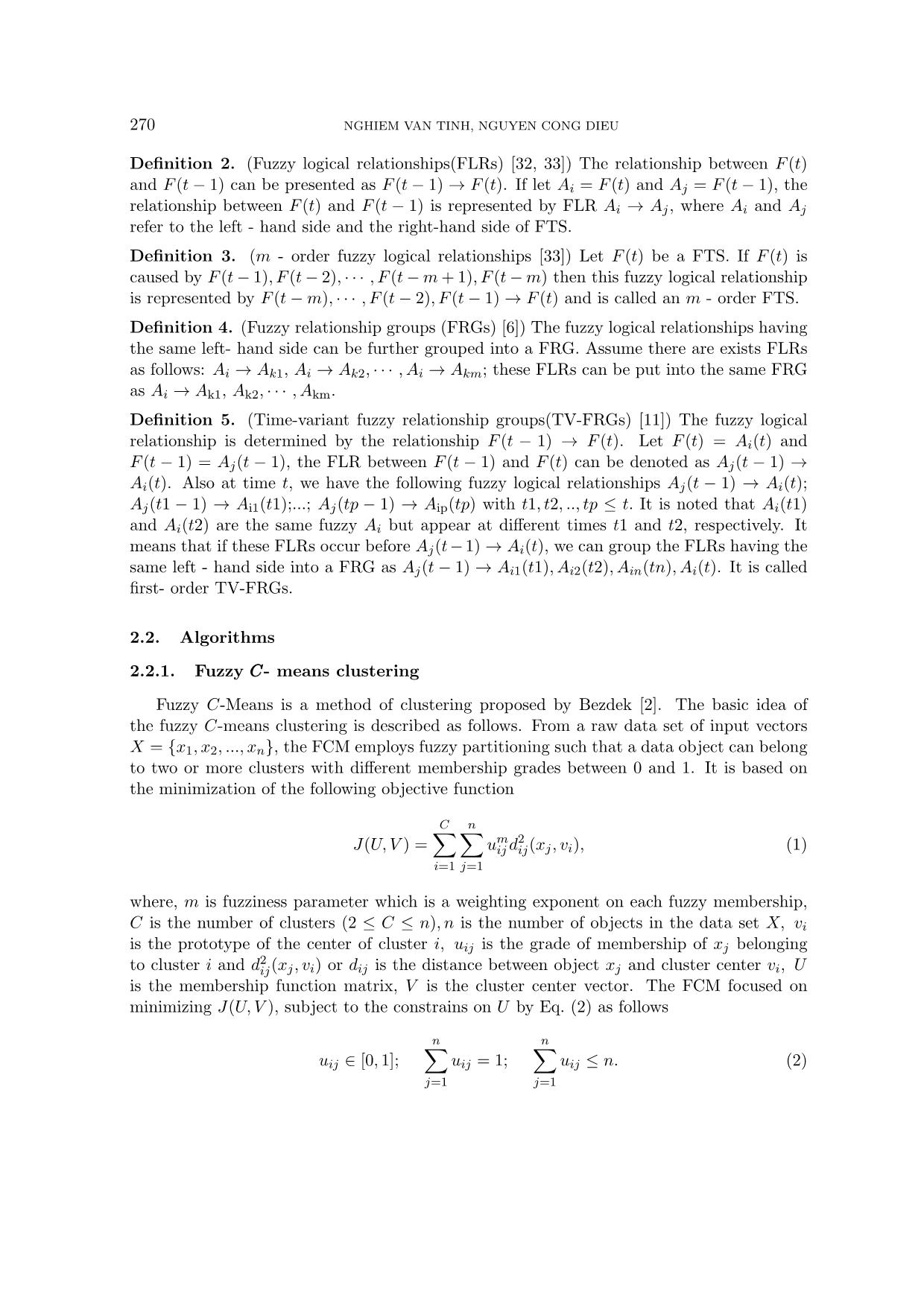
Trang 4
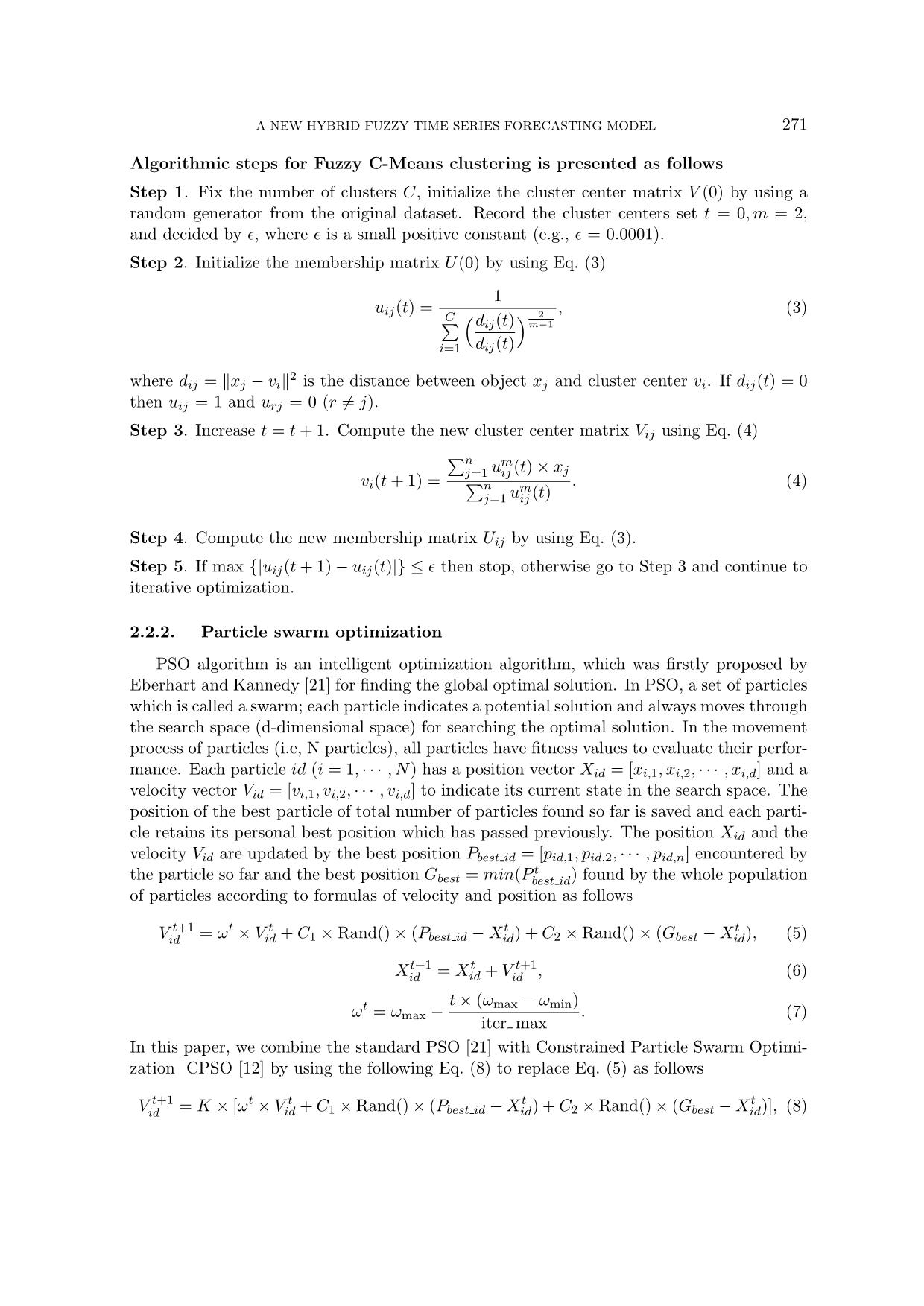
Trang 5
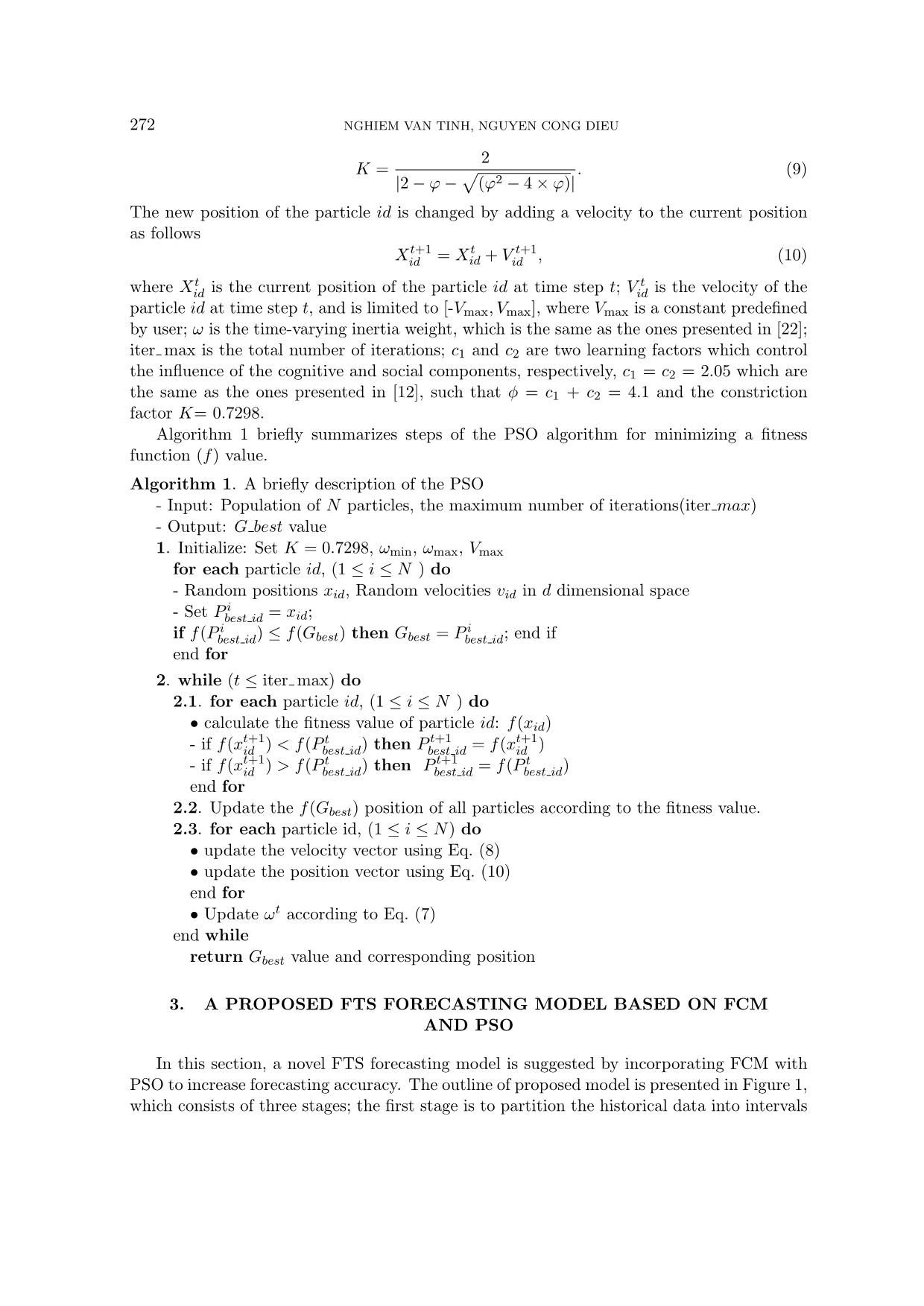
Trang 6
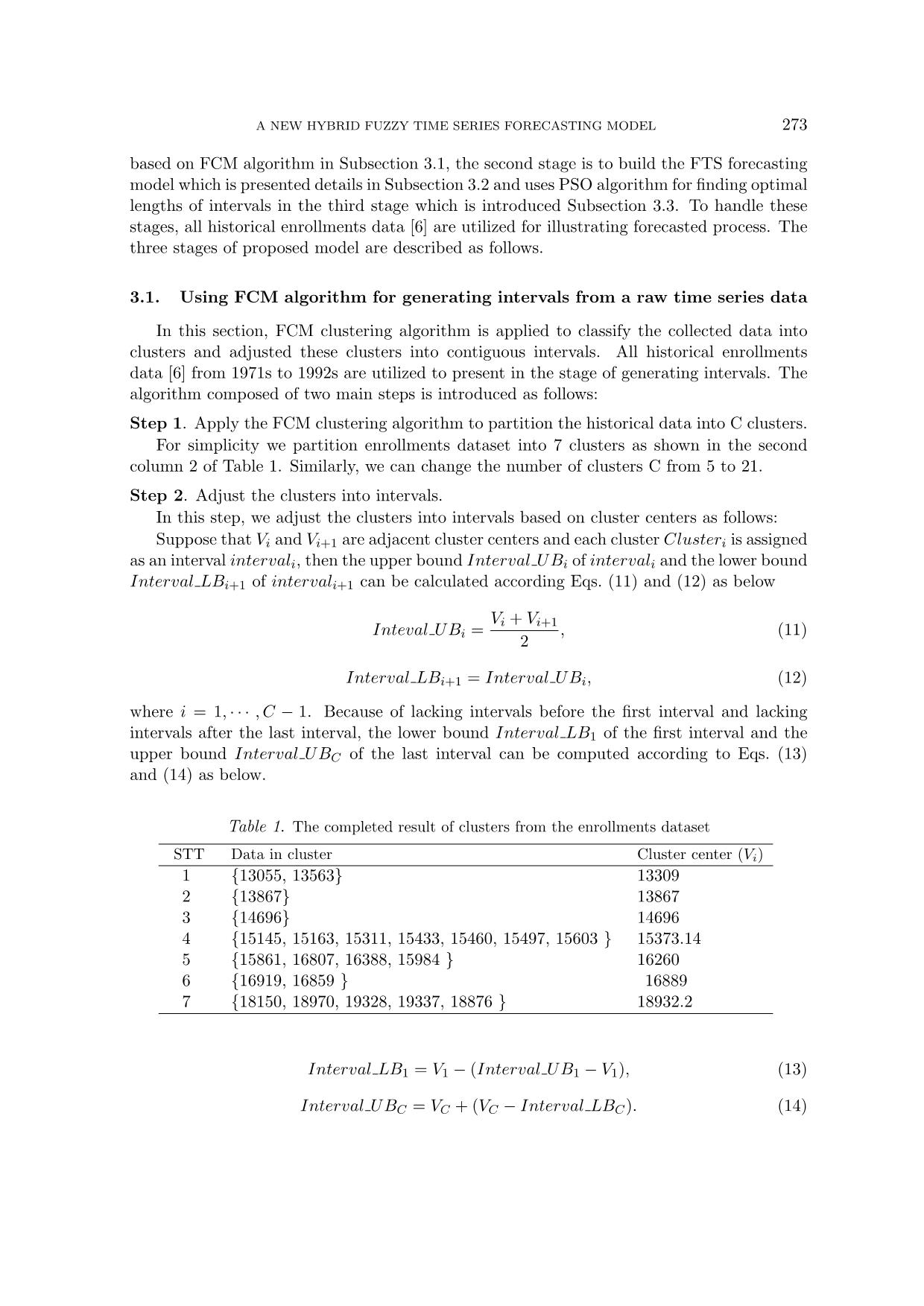
Trang 7
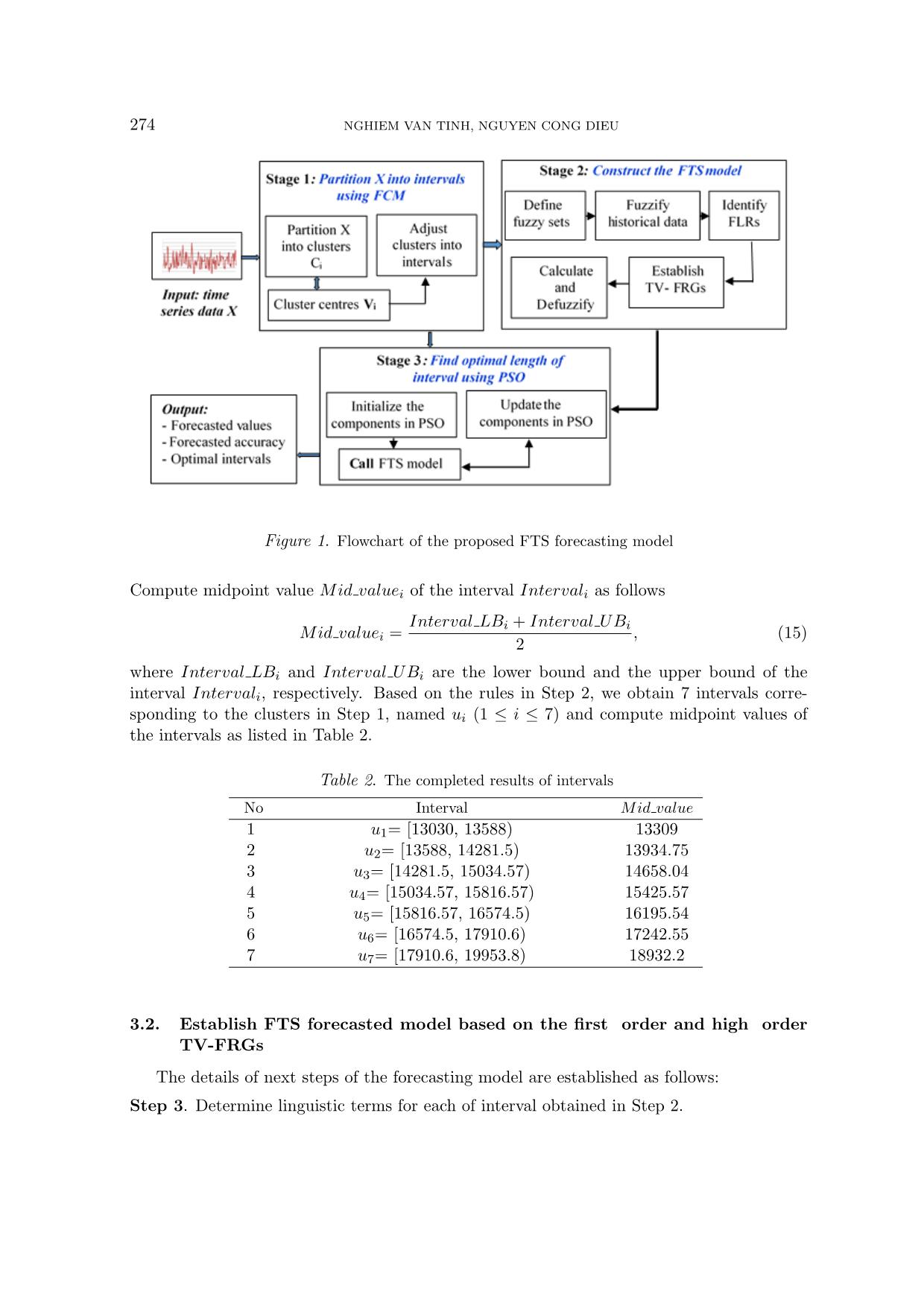
Trang 8
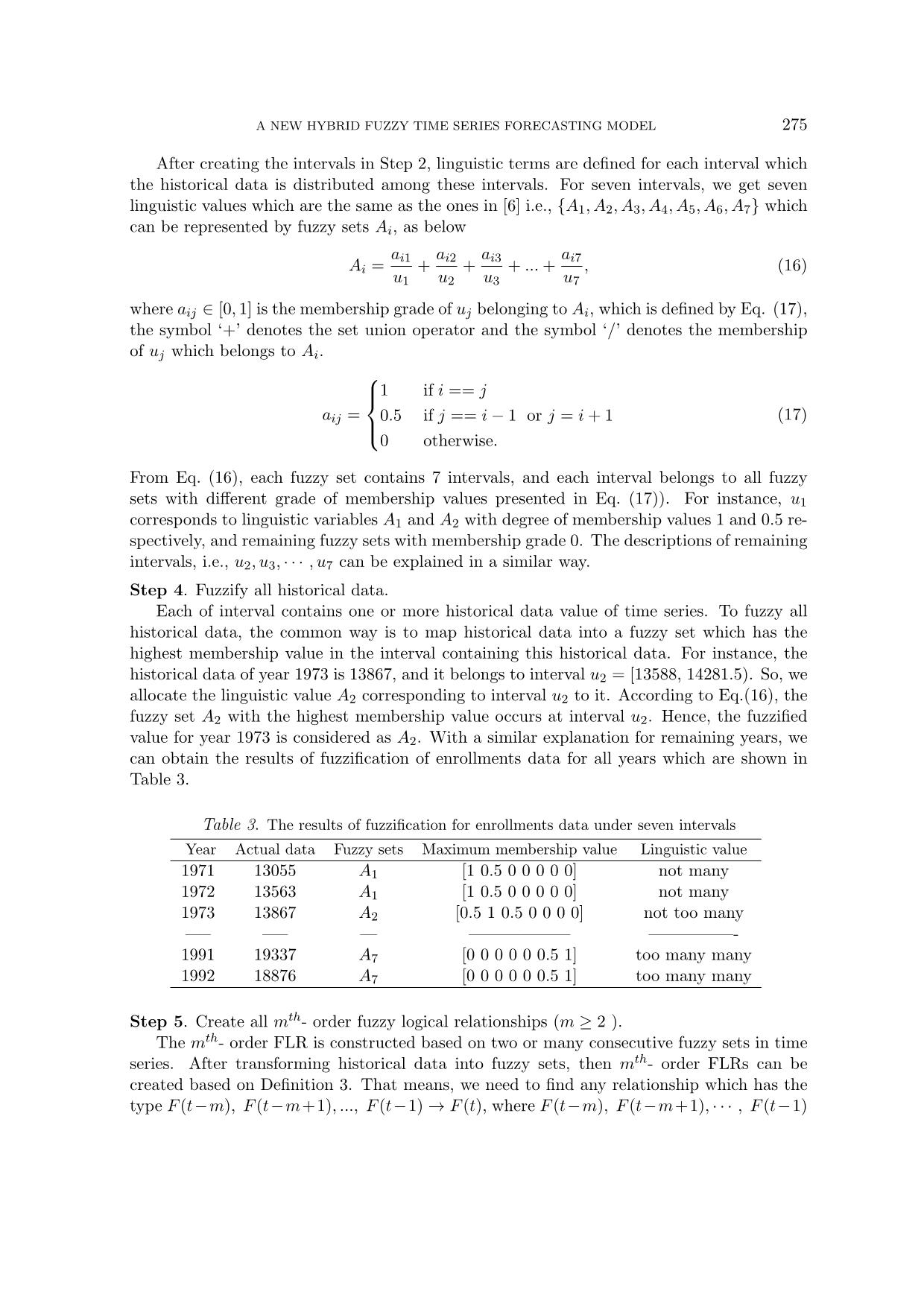
Trang 9
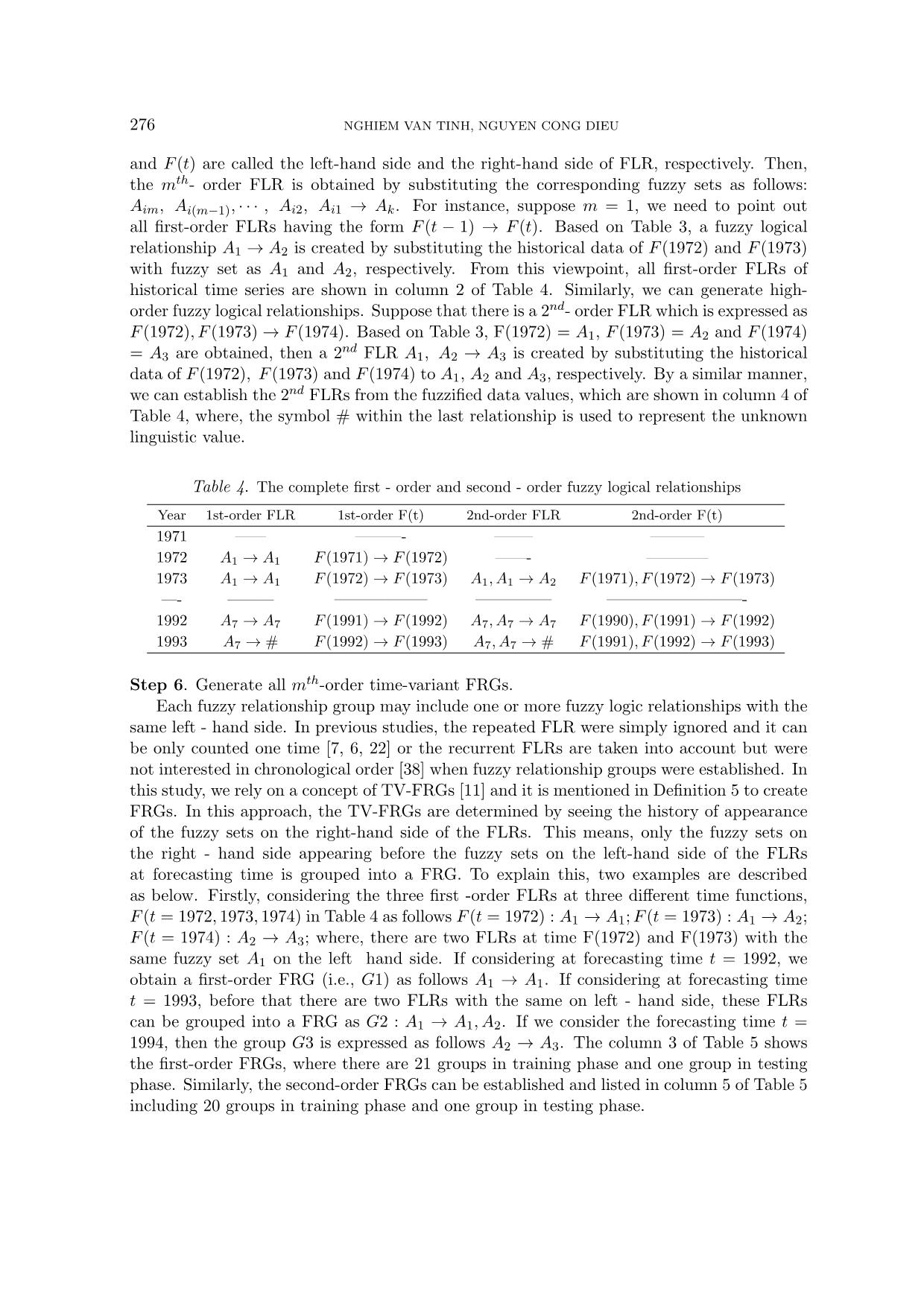
Trang 10
Tải về để xem bản đầy đủ
Tóm tắt nội dung tài liệu: A new hybrid fuzzy time series forecasting model based on combing fuzzy C-Means clustering and particle swam optimization
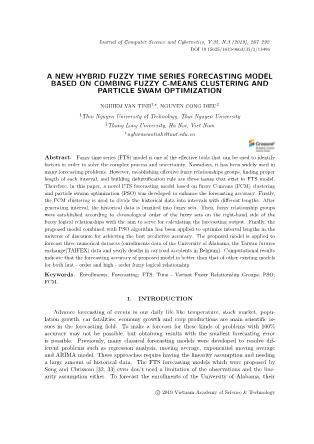
FEX index is split in two parts for independent testing. The first part is used as a training dataset and the second part is used as a testing dataset. From historical data in the past few days, we can forecast the new TAIFEX index for the next day. In this paper the historical data of TAIFEX between March 8, 1998 and September 23, 1998 was used as a training dataset and the remaining data was used in the testing phase. To forecast for testing dataset, the highest votes(wh) for MV scheme in model [22] are used as 3. Other parameters are taken similar to training set. For instance, for forecasting the new data of date 9/24/1998, the data under days from 8/3/1998 to 9/23/1998 are utilized as the training dataset. Similarly, a new data of date 9/25/1998 can be forecasting based on the data of dates between 8/3/1998 and 9/24/1998. A comparison of results for actual data and the forecasting results between the proposed model and the models [15, 22, 24] which use 16 intervals with the 3rd - order FTS. The results in Table 13 indicate that the proposed model is more precise than four compared models based on 3rd - order FTS and also gets the smallest MSE of 116.37. 4.4. Experimental results for forecasting the vehicle road accidents In addition, the proposed model is also used for forecasting the vehicle road accidents in Belgium [1] from 1974 to 2004 and there is made a comparison of the forecasting results with the previous works [1, 19, 20, 39]. A comparison of the forecasting results using RMSE (24) is shown in Table 14. It is evident that the proposed method gets better forecasting results than the forecasting models above. More detailedly comparison, for the same number of interval of 13, the proposed model obtains the smallest RMSE value of 1.96 among two models [20, 39] using the 3rd - order FTS. Beside that, the proposed model also has far smaller RMSE value than model [19] and model [39] based on first - order FTS with different number of intervals. To sum up, demonstrations above show that the proposed model outperform the existing models based on both the first- order and high -order FTS model with different number of intervals in forecasting the vehicle road accidents. 288 NGHIEM VAN TINH, NGUYEN CONG DIEU Table 12. A comparison of the forecasting results of the proposed method with the existing models based on the high - order FTS under number of intervals = 16 Date Actual data H01b L08 HPSO MPTSO THPSO NPSO Proposed model 8/3/1998 7552 N/A N/A N/A N/A N/A N/A N/A 8/4/1998 7560 7450 N/A N/A N/A N/A N/A N/A 8/5/1998 7487 7450 N/A N/A N/A N/A N/A N/A 8/6/1998 7462 7500 N/A N/A N/A N/A 7452.54 N/A 8/7/1998 7515 7500 N/A N/A N/A N/A 7331.62 N/A 8/10/1998 7565 7450 N/A N/A N/A N/A 7285.63 7361.5 8/11/1998 7360 7300 N/A N/A N/A N/A 7331.62 7361.5 8/12/1998 7330 7300 7329 7289.56 7325.28 7325 7291.67 7328.16 8/13/1998 7291 7300 7289.5 7320.77 7287.48 7287.5 7217.15 7290.41 —– —– —– —– —– —– —– —– —– 9/29/1998 6806 6850 6796 6800.07 6781.01 6794.3 7331.62 6810.92 9/30/1998 6787 6750 6796 7289.56 6781.01 6794.3 7285.63 6789.25 MSE 5437.58 105.02 103.61 92.17 55.96 35.86 5.1 Table 13. A comparison of the MSE value for testing phase based on 3rd-order FTS under 16 intervals using wh = 3. Date Actual data Model [25] Model [23] Model [16] Proposed model 9/24/1998 6890 6959.07 6861.0 6916.62 6886 9/25/1998 6871 6833.52 6897.8 6886.0 6874 9/28/1998 6840 6896.95 6912.8 6892.4 6852 9/29/1998 6806 6863.76 6858.4 6871.54 6825.88 9/30/1998 6787 6823.38 6800.5 6859.12 6791.2 MSE 2815.69 1957.42 2635.23 116.37 Table 14. A comparison of the forecasting results between proposed model and various models based on first - order and high - order FLRs Year Actual data Model [20] Model [21] Model [1] Model [40] Proposed model 1st-order 3rd-order 1974 1574 —- — —- —- —- —- 1975 1460 1497 —- 1458 —- 1445 —- 1976 1536 1497 —- 1467 —- 1548 —- 1977 1597 1497 1497 1606 1594 1582 1597 1978 1644 1497 1497 1592 1643 1609 1642 —- —– —– —– —– —– —- —- 2003 1035 995 997 1097 1036 1041 1039 2004 953 995 997 929 954 954 950 RMSE 83.12 46.78 37.66 19.2 16.68 1.96 A NEW HYBRID FUZZY TIME SERIES FORECASTING MODEL 289 5. CONCLUSION AND FUTURE WORK In this study, a new FTS forecasting model which combines FCM and PSO algorithm is proposed for forecasting real-world time series. The advantages of the proposed model are that it combines the PSO and FCM to get the optimum partition of the intervals for increasing the forecasting accuracy rates. The time variant - fuzzy relationship groups were established to overcome the shortcomings of the conventional FTS model which also uses the fuzzy relationship groups. In addition to that the paper also proposes a new defuzzification method for calculating the forecasting output values, which has been the main contribution issue for improving forecasting accuracy of the proposed model. From the empirical study on three datasets of forecasting enrollments, TAIFEX forecasting and car road accidents forecasting, the experimental results show that the proposed model outperforms other ex- isting forecasting models with various orders and different interval lengths. The detail of comparison was presented in Tables 8 - 14 and Figs. 3 - 4. Even though, the proposed method shows that the superior forecasting capability com- pared with existing forecasting models, there still remain some aspects which needs to be mentioned, such as the computational complexity when combining many methods in fo- recasting model and the forecasting of multi-factor problems. To continue evaluating the performance of the forecasting model and overcoming those weaknesses. There are two sug- gestions for future research as the proposed model need to combine with some more effective optimal techniques to deal with more complicated and multi-factor factors problems for decision-making such as: weather forecasting, monthly inflation, and so on. Moreover, we will study some methods for automatically determining the optimal order of the fuzzy logical relationship for forecasting real-world time series. The main contributions of this paper are summarized as below: 1) The appearance of fuzzy sets on the right - hand side of the fuzzy relationship group is considered in the process of determining the FRGs, which makes a more effective use of the historical data and become more reasonable in reality; 2) The forecasting accuracy of FTS model constructed on basis of unequal-sized intervals that are formed by combining FCM with PSO is prominently improved; 3) The information on the right - hand side of all fuzzy logical relationships are considered to calculate the forecasting output by the new defuzzification technique. REFERENCES [1] Bas E, Uslu V.R., Yolcu U, Egrioglu E., “A modified genetic algorithm for forecasting fuzzy time series,” Applied Intelligence, vol. 41, no. 2, pp. 453–463, 2014. [2] Bezdek J C., Pattern Recognition with Fuzzy Objective Function Algorithms. Plenum, press. 1981. [3] Bosel M, Mali K., “A novel data partitioning and rule selection technique for modelling high- order fuzzy time series,” Applied Soft Computing, vol. 67, pp. 87–96, February 2018. [Online]. Available: https://doi.org/10.1016/j.asoc.2017.11.011 290 NGHIEM VAN TINH, NGUYEN CONG DIEU [4] Chen S-M, Chung N.-Y., “Forecasting enrollments of students by using fuzzy time series and genetic algorithm,” International Journal of Information and Management Sciences, vol. 21, no. 5, pp. 485-501, 2006. [5] Chen S-M, Jian W.-S., “Fuzzy forecasting based on two-factors second-order fuzzy-trend logical relationship groups, similarity measures and PSO techniques,” Information Sciences, volumes 391-392, pp. 65–79, June 2017. [6] Chen S M., “Forecasting enrollments based on fuzzy time series,” Fuzzy Sets and Systems, vol. 81, no. 3, pp. 311–319, August 1996. [7] Chen S M., “Forecasting enrollments based on high-order fuzzy time series,” Journal Cyber- netics and Systems An International Journal, vol. 33, no. 1, pp. 1–16, 2002. [8] Chen S M, Phuong H B D., “Fuzzy time series forecasting based on optimal partitions of intervals and optimal weighting vectors,” Knowledge-Based Systems, vol. 118, pp. 204–216, February 2017. [9] Luc Tri Tuyen, et al., “A normal-hidden Markov model in forecasting stock index,” Journal of Computer Science and Cybernetics, vol. 28, no. 3, pp. 206–216, 2012. [10] Cheng S H, Chen S-M, Jian W S., “Fuzzy time series forecasting based on fuzzy logical relati- onships and similarity measures,” Information Sciences, vol. 327, pp. 272–287, 2016. [11] Dieu N C, Tinh N V., “Fuzzy time series forecasting based on time depending fuzzy relationship groups and particle swarm optimization,” Proceedings of the 9th National Conference on Fundamental and Applied Information Technology Research (FAIR’9), Can Tho, Viet Nam, 2016, pp. 125–133. [12] Eberhart R C, Shi Y., “Comparing inertia weights and constriction factors in particle swarm optimization,” Proceedings of the 2000 IEEE Congress on Evolutionary Computation, La Jolla California U. S. A, 2000, pp. 84–88. [13] Egrioglu E, Aladag C H, Yolcu, “Fuzzy time series forecasting with a novel hybrid approach combining fuzzy c-means and neural network,” Expert Systems with Applications, vol. 40, no. 3, pp. 854–857, 2013. [14] Egrioglu E, Aladag C H, Yolcu U, Uslu V R, Basaran M A., “Finding an optimal inter-val length in high order fuzzy time series,” Expert Systems with Applications, vol. 37, no. 7, pp. 5052–5055, 2010. [15] Hsu L-Y, et al., “Temperature prediction and TAIFEX forecasting based on fuzzy relationships and MTPSO techniques,” Expert Systems with Applications, vol. 37, no. 4, pp. 2756–2770, 2010. [16] Huang Y L, et al., “A hybrid forecasting model for enrollments based on aggregated fuzzy time series and particle swarm optimiza-tion,” Expert Systems with Applications, vol. 38, no. 7, pp. 8014–8023, 2011. [17] Huarng K., “Effective lengths of intervals to improve forecasting in fuzzy time series,” Fuzzy Sets and Systems, vol. 123, no. 3, pp. 387–394, 2001. [18] Hwang J R, Chen S M, Lee C H., “Handling forecasting problems using fuzzy time series,” Fuzzy Sets and Systems, vol. 100, no. 1–3, pp. 217–228, 1998. A NEW HYBRID FUZZY TIME SERIES FORECASTING MODEL 291 [19] Jilani T A, Burney S. M. A., Ardil C. Multivariate high order FTS forecasting for car road accident. World Acad Sci Eng Technol. vol. 25, pp. 288 – 293, 2008. [20] Jilani T A, Burney S M A., “Multivariate stochastic fuzzy forecasting models,” Expert Systems with Applications, vol. 35, no. 3, pp. 691–700, 2008. [21] Kennedy J, Eberhart R. Particle swarm optimization, in: Proceedings of the IEEE In- ternational Conference on Neural Networks,Perth, Australia:pp. vol.4, 1942–1948, 1995, [22] Kuo I-H, et al., “An improved method for forecasting enrollments based on fuzzy time series and particle swarm optimization,” Expert Systems with Applications, vol. 36, no. 3, part 2, pp. 6108–6117, 2009. [23] Kuo I-H, et al., “Forecasting TAIFEX based on fuzzy time series and particle swarm optimi- zation,” Expert Systems with Applica-tions, vol. 37, no. 2, pp. 1494–1502, 2010. [24] Lee L-W, Wang, L.-H., Chen, S.-M., “Temperature prediction and TAIFEX forecasting based on high order fuzzy logical relationhip and genetic simulated annealing techniques,” Expert Systems with Applications, vol. 34, pp. 328–336, 2008. [25] Lee L W, Wang L H, Chen S M, Leu Y H., “Handling forecasting problems based on two- factors high-order fuzzy time series,” IEEE Transactions on Fuzzy Systems, vol. 14, no. 3, pp. 468–477, 2006. [26] Loc V M, Nghia P T H. Context-aware approach to improve result of forecasting enrollment in fuzzy time series. International Journal of Emerging Technologies in Engineering Research (IJETER) vol.5, no.7, pp.28–33, 2017. [27] Lu. W, XueyanChen., Xiao-dongLiua. W, JianhuaYang, “Using interval information granules to improve forecasting in fuzzy time series,” International Journal of Approximate Reasoning, vol. 57, pp. 1–18, 2015. [28] Park J I, Lee D.J., Song C.K., Chun M.G., “TAIFEX and KOSPI 200 forecasting based on two- factors high-order FTS and particle swarm optimization,” Expert Systems with Applications, vol. 37, no. 2, pp. 959–967, 2010. [29] Rubinstein S, Goor A, Rotshtein A., “Time series forecasting of crude oil consumption using neuro-fuzzy inference,” Journal of Industrial and Intelligent Information, vol. 3, no. 2, June 2015. [30] Singh P, Borah B., “An effective neural network and fuzzy time series based hybridized model to handle forecasting problems of two factors,” Knowledge and Information Systems, vol. 38, no. 3, pp. 669–690, March 2014. [31] Singh S R., “A simple method of forecasting based on fuzzy time series,” Applied Mathematics and Computation, vol. 186, no. 1, pp. 330–339, 2007. [32] Song Q, Chissom B S., “Forecasting enrollments with fuzzy time series - Part I,” Fuzzy Sets and Systems, vol. 54, no. 1, pp. 1–9, 1993. [33] Song Q, Chissom B S., “Fuzzy time series and its models,” Fuzzy Sets and Systems, vol. 54, no. 3, pp. 269–277, 1993. 292 NGHIEM VAN TINH, NGUYEN CONG DIEU [34] Tian Z H, Wang P, He T Y., “Fuzzy time series based on K-means and particle swarm op- timization algorithm,” International Conference on Man-Machine-Environment System Engineering. Man-Machine-Environement System Engineering. 2017, pp. 181–189. [On- line]. Available: https://link.springer.com/chapter/10.1007/978-981-10-2323-1 21 [35] Tinh N V, Dieu N C., “Novel forecasting model based on combining time-variant fuzzy rela- tionship groups and K-means clustering technique,” Proceedings of the 9th National Con- ference on Fundamental and Applied Information Technology Research(FAIR10), Can Tho, Viet Nam, 2017. Doi: 10.15625/vap.2017.0002 [36] Nghiem Van Tinh, Nguyen Cong Dieu, “A new hybrid fuzzy time series forecasting model combined the time -variant fuzzy logical relationship groups with particle swam optimization,” Computer Science and Engineering, vol.7, no.2, pp.52–66, 2017. [37] Yu H K., “A refined fuzzy time-series model for forecasting,” Physical A: Statistical Mecha- nics and its Applications, vol. 346, no. 3–4, pp. 657–681, 2005. [38] Yu H K., “Weighted fuzzy time series models for TAIEX forecasting,” Physical A: Statistical Mechanics and its Applications, vol. 349, no. 3–4, pp. 609–624, 2005. [39] Yusuf S M, Mu’azu M B, Akinsanmi.O., “A novel hybrid fuzzy time series approach with applications to enrollments and car road accident,” International Journal of Computer Ap- plications, vol. 129, no. 2, pp. 37–44, 2015. [40] Pham Thi Minh Phuong, Pham Huy Thong, Le Hoang Son, “Theoretical analysis of picture fuzzy clustering,” Journal of Computer Science and Cybernetics, vol. 34, no. 1, pp. 17–31, 2018. Received on December 22, 2018 Revised on April 25, 2019
File đính kèm:
 a_new_hybrid_fuzzy_time_series_forecasting_model_based_on_co.pdf
a_new_hybrid_fuzzy_time_series_forecasting_model_based_on_co.pdf

